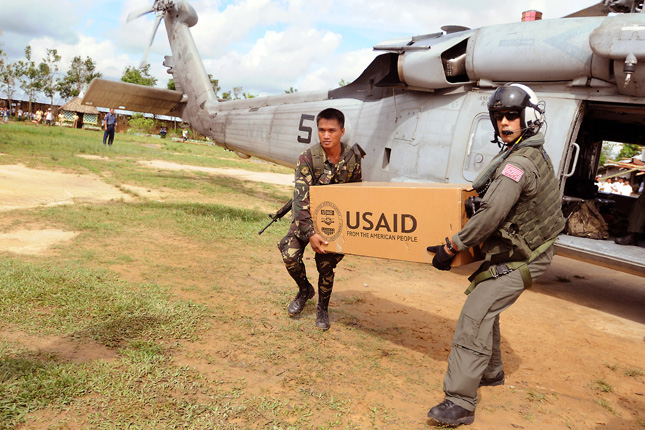-
“Food Power”: American Postwar Diplomacy and Food for Peace
April 17, 2018 By Bethany N. Bella
Food has long been used by countries to wage both war and peace, and the post-war era of American food dominance is no exception. Bryan McDonald, a professor at Pennsylvania State University, traces the United States’ “Food For Peace” strategy in his recent book, Food Power: The Rise and Fall of the Postwar American Food System, arguing that “food was central to national security” during this period.
“These efforts also demonstrated the ability to utilize food as a form of assistance to those in need while also establishing the success of the American way in the postwar years,” McDonald writes. “Abundance was the foundation of an international food system, and the United States was at its center.”
Food Aid: A National Security Tool
“Food is one of the main ways that we structure our relationship with other people and the environment on a day-to-day basis,” McDonald said in an interview. “The impact of human relationships with food goes way beyond the act of eating.”
In Food Power, McDonald explores the evolution of American food policy during the mid-20th century, documenting how the United States deliberately deployed its “food power” after World War II to achieve diplomatic aims favorable to U.S. democracy.
American foreign food assistance was a stabilizing force for global marketsAmerican foreign food assistance was a stabilizing force for global markets, boosting the United States’ legitimacy as a democratic world leader both at home and abroad. “Food was always valuable, but in the wake of a global food crisis from 1972 to 1974, there was renewed attention to the link between food and security,” McDonald writes.
“The ability of the United States to dispense food to help those in need—even the Soviet Union—was something that government leaders would point to again and again as evidence that the American system was superior to communism,” McDonald writes.
Today, there are far fewer small, independent American farmers, due to increased mechanization, industrial farming techniques, and large corporate acquisitions. But the food industry still matters a great deal to the American economy—and to its growing appetite.
“Very few people in America actually grow food, but one in nine jobs in the United States is related to food,” McDonald said. “Economic vibrancy is a core part of what makes us a great nation, and yet we’re not really focusing on how can we provide stability and good lives for the people who are producing food.”
The last time food played a major part in an American presidential campaign, McDonald argues, was during the 1960 election of President John F. Kennedy.
Since then, “We’ve been lulled in a sense by our lived experiences, in a world where most of Americans have enough food to eat,” McDonald said.
The Future of Food Assistance
One of the reasons the United States was a successful superpower in the post-war era, McDonald argues, is its “constant involvement” in humanitarian efforts and diplomacy overseas.
“Historically, the peace, the prosperity, the stability we saw—it wasn’t an accident,” McDonald said. “The U.S. was deeply engaged in the world. We were willing to fund development…we were making progress on public health goals, and it cascaded forward.
“Historically, the peace, the prosperity, the stability we saw—it wasn’t an accident”“You get this incredible period of peace and stability – and no food crisis.”
But when “the Cold War ends, and the U.S. and the Soviet Union stop providing a lot of the assistance that they were providing, we get into this period of uncertainty, a period of instability,” McDonald said.
Recently, as nationalist politics have surged in the United States and Europe, some have threatened to draw down foreign aid and instead focus on their own infrastructure and development.
According to McDonald, the global development framework now looks more like a “patchwork—it’s not a tightly woven blanket that is focused on the needs of countries, the needs of people in those countries.”
“Food is too critical a component in global peace and prosperity to be left to the heightened by short-lived attention it receives during a crisis,” McDonald writes.
In addition, climate change may disrupt agricultural patterns and upend food security. “We don’t know what’s going to happen,” McDonald said. “That’s the climate reality that we live in.”
“If you look at every trend out there – climate change, the number of hungry people in the world, the number of people who are acutely food insecure, the number of people displaced from conflict—all of those tell you that we are headed in the wrong direction,” McDonald said.
These food security and climate change trends have ramifications for national security. “The landscape of security threats that the U.S. is facing is shifting,” McDonald said. “We’re making a dangerous bet, to move into a more uncertain future through not investing—not just overseas, but in ourselves.
“Do we want to trust to luck, or do we want to make our own luck?”
Bethany N. Bella is a Bachelor of Specialized Studies senior studying environmental geography and women’s & gender studies at Ohio University. Find her on Twitter or visit her website.
Sources: Pew Research
Photo Credit: Humanitarian operations on Panay Island, Philippines, June 2008, courtesy of DVIDSHUB.
 A Publication of the Stimson Center.
A Publication of the Stimson Center.



